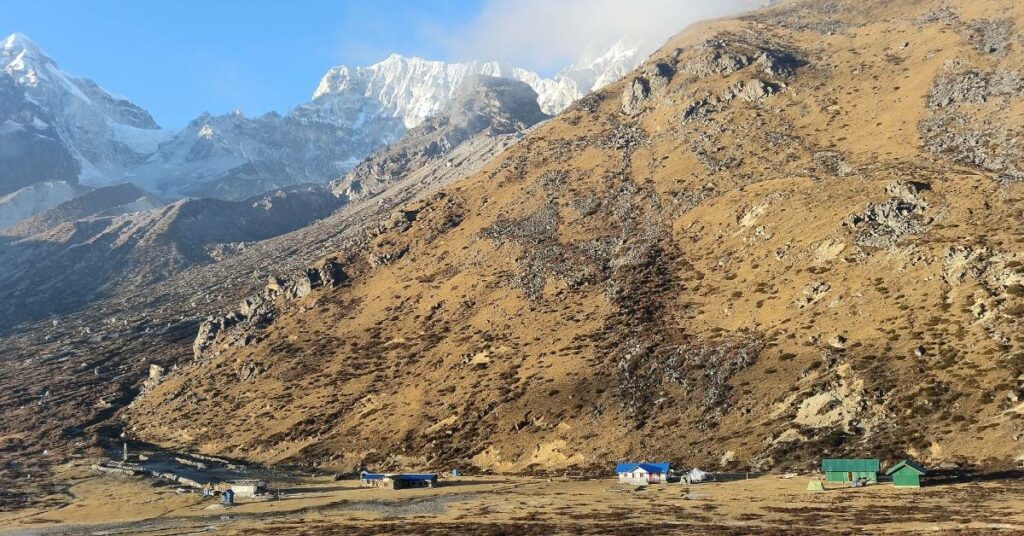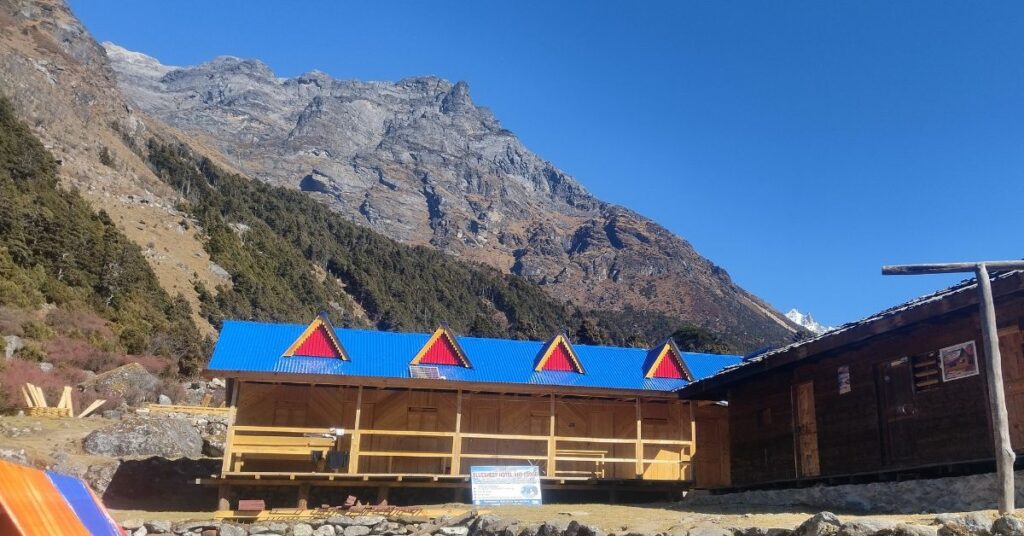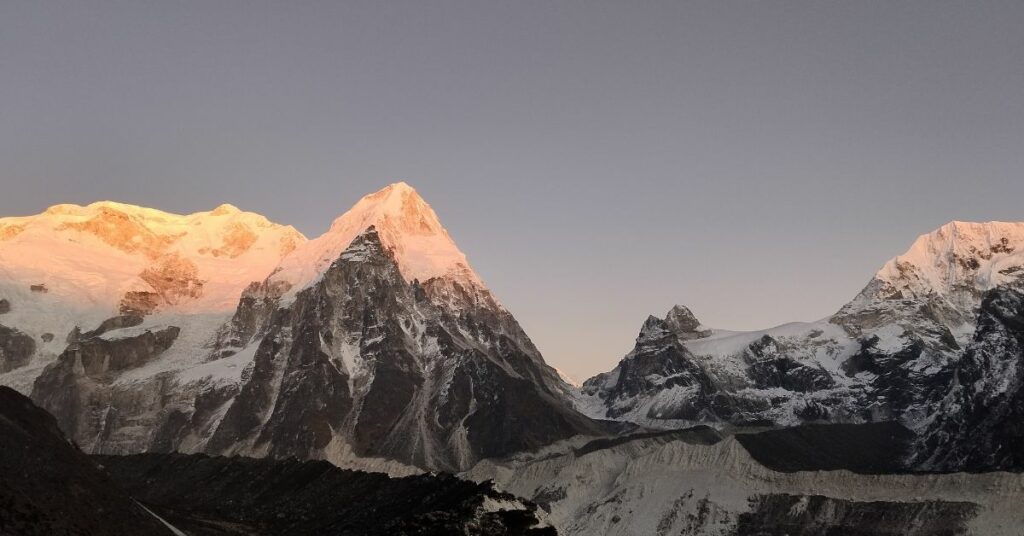How Much Does it Cost to Trek Kanchenjunga?
The Kanchenjunga Trek is a journey into a world where nature, history, and culture come together in an unforgettable way. Once thought to be the highest mountain in the world, this mighty peak continues to draw adventurers with its majestic appeal. The trek takes you into the Kanchenjunga Conservation Area, a protected region that remains untouched by modern life. Besides its natural beauty, this trek is also a cultural experience. You will pass by ancient monasteries and temples and visit local communities. Like the ones of Rai, Sherpa, Limbu, and Gurung, whose kindness and traditions make the journey even more special. Tasting local foods like Tongba adds to the adventure, making it a true exploration of Himalayan culture.
The Kanchenjunga Trek requires careful budgeting, as the cost usually falls between $2,000 -$2,500 per person. This price includes permits, guide and porter services, transportation, lodging, and meals. In this guide, we’ll explain these costs, how your choices can affect your budget, and tips to help you plan your trek smoothly. By understanding your expenses, you can focus on enjoying the view and making the most of this incredible adventure in the Himalayas.
An Introduction to the Trek
Kanchenjunga is Nepal’s third-highest peak, standing at 8,586 meters. The trek to its base camps is one of the country’s most remote and rewarding experiences. Unlike more commercialized treks like Everest or Annapurna, the Kanchenjunga Trek offers an offbeat path with breathtaking views. It also provides a chance to connect with nature.
Since it is a restricted area, you need special permits and a registered guide to trek in Kanchenjunga. This makes planning more complicated and expensive. But for those who want peace and a chance to see Nepal’s natural beauty, Kanchenjunga is worth every penny.
A Detailed Overview of the Trek’s Route and Scenic Beauty

You can reach Kanchenjunga through two main routes: the North Base Camp (Pangpema) and the South Base Camp (Oktang). Many trekkers choose to complete a full circuit, linking both camps through the Sele La Pass at 4,290 meters. The journey starts in Taplejung, a remote town in eastern Nepal. You can get there by flying to Bhadrapur and then taking a jeep ride. Along the way, you’ll pass through traditional villages like Mitlung, Chirwa, and Ghunsa, where Tibetan culture is strong. The trek also features ancient monasteries, colorful prayer flags, and the welcoming hospitality of the locals.
One of the most exciting parts of the trek is the Yalung Glacier viewpoint at the South Base Camp, where you can see Kanchenjunga’s massive south face up close. The North Base Camp is just as stunning, offering breathtaking views of Jannu (7,710 meters), also called “Mystery Peak.”
Mastering the Budget: A Thorough Breakdown of the Costs Involved in the Kanchenjunga Trek
Planning your Kanchenjunga Trek involves a wide range of expenses that you need to carefully consider. These costs can vary greatly depending on several factors, such as the type of services you choose, the duration of your trek, and the season in which you decide to travel. Additionally, the time of year you embark on your trek plays a crucial role in determining costs, as peak season often brings higher prices for accommodations, permits, and other services.
The Bottom Line: Understanding the Average Cost Estimate and What It Covers
The total cost for the Kanchenjunga Trek can range from $2300 to $5000, depending on your choices. This typically includes permits, guide and porter fees, accommodation, transportation, and miscellaneous expenses.
- Permits: The Kanchenjunga Trek requires two main permits: the Kanchenjunga Conservation Area Permit (KCAP), costing around $30, and the Restricted Area Permit, which is $20 per week. Please note, a minimum of two trekkers is required for the restricted area permit.
- Guide and Porter Fees: Hiring a guide costs approximately $30–$40 per day, while a porter’s fee ranges from $20–$30 per day. Both are essential for navigating the trek and carrying your gear.
- Accommodation & Food: Expect to pay around $15–$40 per day for accommodation and meals, depending on whether you stay in basic teahouses or opt for camping.
- Transportation: Flights from Kathmandu to a nearby regional airport generally range between $100 and $200 one-way. From there, a jeep ride to Taplejung typically costs between $40 and $70.
- Miscellaneous: Additional expenses like gear rental, travel insurance, tips, and snacks can add another $200–$500 to your overall budget.
How Trek Duration, Season, and Accommodation Options Impact Your Budget?
When planning the Kanchenjunga Trek, understanding how different factors affect your budget is essential for effective trip preparation. Key elements like the duration of your trek, the season you choose to travel, and the type of accommodation you opt for can significantly influence your overall expenses. By considering these aspects, you can better estimate your costs and make informed decisions to ensure your trek is both affordable and aligned with your expectations. Let’s explore how each of these factors plays a role in shaping your budget for this incredible Himalayan adventure.
- Trek Duration: The longer the trek, the higher your expenses. Extended treks require more days for accommodations, meals, and guide or porter services, which all contribute to the overall cost. A shorter trek will generally cost less, but you may miss out on some of the trek’s highlights.
- Time of Year: Trekking in peak seasons (spring and autumn) is more expensive because of higher demand. During these months, accommodation and guide fees rise, and availability can be limited. Off-season treks tend to be cheaper but come with added risks like unpredictable weather and fewer trekking facilities.
- Accommodation and Food: Accommodation prices at basic tea houses along the trek range from $5 to $15 per night, while meals typically cost $5 to $10. The choice between staying in simple tea houses or opting for more luxurious accommodation will impact your daily costs.
By factoring in the duration, season, and your accommodation preferences, you can plan a trek that aligns with both your budget and your expectations for the experience.
Time and Season: How These Elements Influence Your Trek Experience and Cost
The best time to trek Kanchenjunga is in spring (March–May) and autumn (September–November). During these months, the weather is stable, and the skies are clear. Visibility is excellent, allowing trekkers to enjoy stunning mountain views. The temperatures are also moderate, making the trek more comfortable. However, costs are higher during these peak seasons. Accommodation prices go up as more trekkers visit the region. Meal costs may also increase slightly. Flights to Bhadrapur and transport to Taplejung become more expensive because of high demand. Additionally, guides and porters may charge higher daily rates since they have more work during this time.
Trekking in the winter season (December to February) is also an option you can opt for. The winter season in Nepal is extremely cold, especially at higher altitudes. Temperatures drop well below freezing, making the trek more difficult. Heavy snowfall can block high mountain passes. This can make certain parts of the trek impassable. However, winter is the off-season, meaning fewer trekkers on the trails. Because of this, the cost of accommodation and food is lower. Some lodges may offer discounts to attract trekkers. However, accessibility can be a problem. You may need to spend extra money on hiring additional porters or arranging emergency evacuations if needed.
Lastly, the Monsoon season (June to August) is the least favorable time for trekking. Heavy rainfall makes the trails muddy and slippery. Landslides can block roads and paths, creating unexpected delays. Leeches are also a common problem during this season. Many teahouses in higher altitudes may be closed due to bad weather. Flights and transport might be cheaper since fewer people travel during the monsoon season. However, you may need to spend extra on waterproof gear and insect protection. Road travel can be unpredictable. Last-minute changes in plans may require extra money for extended stays or taking alternative routes.
Where to Stay: Exploring the Different Accommodation Options Available Along the Trek

Accommodation along the Kanchenjunga Trek mainly consists of teahouses, where you can expect to pay around $5–$15 per night for basic lodging. Meals typically cost $5–$10 per meal, making daily expenses range from $20 to $40.
If you prefer a camping trek, the cost increases due to the need for tents, cooking staff, and additional porters. A fully supported camping trek can cost around $60–$100 per day, covering food, accommodation, and wages for support staff.
How Service Requirements Can Enhance or Reduce Your Overall Cost?
Being a restricted area, the Kanchenjunga trek requires you to hire guide and porter services. Porters and guides can enhance the quality of your trek with their services. A licensed guide will charge $30–$40 a day, and their service is to lead, ensure safety, provide you help with permits, and offer cultural information. Porters, who carry gear and lighten your pack, charge $20–$30 a day. A porter can carry 20-25 kg on average, so a single porter can be shared by two trekkers if the bags are light.
Whether or not to hire a guide and a porter is based on your capability and condition. If hiking with your own backpack is no problem, but you could do with guide and translation assistance, having one guide would suffice. However, if reaching high altitudes is a hassle, it is recommended that you hire a porter. Also, observe that tipping is the standard practice and that you should pay an extra $100–$150 for a guide and $50–$100 for a porter at the end of the hike.
Essential Expenses and Considerations for a Successful Trek
Successfully completing the Kanchenjunga Trek requires more than just being physically strong. Careful planning and preparation are important for a safe and smooth journey. Besides getting permits and arranging transportation, there are other important factors to consider. These factors will affect your comfort and overall experience during the trek. Understanding the costs and challenges of the trek will help you prepare better. This way, you can enjoy the stunning views and rich cultural experiences along the way. With the right preparation, you can have a safe and unforgettable adventure.
The Necessary Permits: A Guide to Obtaining the Required Documents for a Smooth Journey
One of the first expenses you’ll encounter is obtaining the necessary permits to trek in the Kanchenjunga region. Since this is a restricted area, it’s crucial to secure the proper documentation before starting your trek. To trek in Kanchenjunga, you must secure the following permits:
1. Kanchenjunga Conservation Area Permit (KCAP)
This permit allows you to explore the stunning Kanchenjunga Conservation Area. This vast wilderness is known for its incredible biodiversity and breathtaking landscapes. The KCAP helps protect this unique region. It ensures that trekkers can continue to enjoy its natural beauty for years to come.
Cost: $30 per person
- What It Covers: It grants access to the Kanchenjunga Conservation Area. This area is home to rare wildlife like the snow leopard and red panda. It also offers clear mountain views.
- How to Get It: Your trekking agency will arrange this permit for you, or you can pick it up directly in Kathmandu. The process is simple, and the permit will be valid for the entire duration of your trek within the conservation area.
2. Restricted Area Permit (RAP)
Since Kanchenjunga is a restricted trekking region, you’ll need a Restricted Area Permit (RAP) to trek through the more remote areas.
This permit helps keep tourism controlled. It helps preserve both the environment and the local culture in the region.
- Cost: $20 per week per person
- What It Covers: It gives you access to the restricted areas surrounding Kanchenjunga, where few trekkers venture, offering an authentic and peaceful experience.
- How to Get It: You can’t obtain the RAP on your own—you’ll need to go through a licensed trekking agency. Traveling agencies can handle all the paperwork for you, and you’ll need to have a minimum of two trekkers in your group (a guide is also mandatory).
- What to Expect: This permit is typically valid for a week, but if you’re planning a longer trek, your agency can help extend it for you. It’s important to plan your trek accordingly so that your permit covers the entire duration.
Most trekkers choose to go through a trekking agency to handle the permit process. The agency will arrange both the KCAP and RAP. The agency will also provide a licensed guide. This is required for trekking in restricted areas. The process is easy. Agencies know how to handle everything for you, including the paperwork. You’ll need to provide a copy of your passport, a passport-sized photo, and some basic travel details, like your trek plan. Once the permits are ready, the agency will make sure you have them before you leave. Remember, these permits are important. They are for your safety, to protect the environment, and to keep the region’s culture. Trekking without the right permits could result in fines or being turned away. This could ruin your trip.
By getting the permits, you follow the rules and help keep this beautiful place safe for future trekkers.
Preparing for the Unexpected: Understanding Physical and Environmental Factors That Can Impact Your Trek
Kanchenjunga is a high-altitude trek, and acclimatization is crucial to avoid altitude sickness. The trek includes crossing several high passes. You will need proper gear for this, like insulated clothing, crampons, and trekking poles. The weather can change quickly, and the area is remote with few medical facilities. Because of this, travel insurance with emergency evacuation coverage is very important.
- Acclimatization: It is important to acclimatize properly to avoid altitude sickness. This can affect trekkers at altitudes above 3,000 meters. The trek includes several high passes. Spending enough time to adjust to the thinner air is key for safety.
- High Passes & Altitude: The trek has several high-altitude passes that are above 4,000 meters. These sections are challenging and require both physical strength and the right gear to safely deal with the low oxygen levels.
- Essential Gear for High Altitude: For Kanchenjunga, you will need insulated clothing, a down jacket, and crampons for icy areas. These items will help keep you safe and comfortable in harsh conditions.
- Unpredictable Weather: The weather in the Kanchenjunga region can change suddenly. You may experience rapid temperature drops, heavy rain, or even snowstorms at higher altitudes. Be ready for extreme weather at any time during the trek.
- Remoteness & Limited Access to Medical Facilities: The trek takes you through very remote areas where there are few healthcare facilities. If you have a medical emergency, it could be hard to get help. This is why travel insurance with emergency evacuation coverage is so important.
Trekking Kanchenjunga with Confidence, Clarity, and Affordable Cost with Mountain Routes

Trekking in Kanchenjunga is an unforgettable adventure. The trek takes you through beautiful landscapes with views of the world’s third-highest peak. The area is peaceful and untouched by mass tourism, offering a truly unique experience. However, due to its remote location, the Kanchenjunga trek can be costly. You’ll need to plan carefully for all your expenses. Understanding these costs ahead of time will help you manage your budget and fully enjoy the trek without surprises.
With Mountain Routes, you can trek with confidence and clarity at an affordable cost. We help you navigate the complexities of the trek, offering expert guidance and support every step of the way. Whether you choose a budget-friendly teahouse trek or a fully supported expedition, we make sure you know exactly what to expect. There are no hidden fees; our team will take care of all the details. At Mountain Routes, we believe in clear, transparent pricing. We make sure you know the costs upfront. This includes the necessary permits, guide and porter fees, and daily expenses for accommodation and food. With over 10 years of experience, our knowledgeable guides are dedicated to your safety and well-being. They ensure you have the best possible experience while trekking in Kanchenjunga
